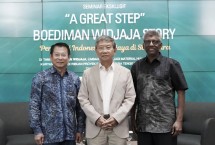Why automation is critical for your software development
By : Taylor Armerding, Senior Security Advocate, At Synopsys Software Integrity Group | Wednesday, May 05 2021 - 23:59 IWST

The Object Management Group and the Consortium for Information & Software Quality (CISQ)
INDUSTRY.co.id - Automation isn’t just a “nice-to-have” element of modern business. It’s a “must-have.” Companies simply can’t compete on multiple levels — quality, speed to market, safety, and security — if they rely on manual tools and processes.
That’s especially true when it comes to software, which powers everything in business from finance to human resources, marketing, products, and services.
The quality of that software is crucial — it has to function as intended and do so safely, reliably, and securely. And when it comes to testing that software for design flaws or random defects in thousands of lines of code, an automated tool can find in milliseconds what it could take a team of humans hours, days or even weeks to find. As is obvious, humans don’t scale.
The importance of quality standards in automation
But automation has to work effectively and reliably as well. If an automated testing tool misses a design flaw in a program controlling a robot on an assembly line, it will multiply problems instead of solving them. If it doesn’t catch a vulnerability in the software for an application or network, it could open an organisation to a catastrophic cyber attack.
Hence the need for quality standards in automation. And the good news is that they now exist, in the form of the International Organisation for Standardisation / International Electrotechnical Commission’s ISO/IEC 5055:2021 – Automated Source Code Quality Measures (ASCQM). The Object Management Group and the Consortium for Information & Software Quality (CISQ) announced publication of the standard on April 7, 2021.
Joe Jarzombek, a retired U.S. Air Force Lt. Colonel with over 30 years of experience with defence agencies, military services, and the defense industry, is the director for government and critical infrastructure programs with Synopsys and a member of the CISQ governing board. He describes ISO 5055 as a “standard for measuring the internal structure of a software product on four business-critical factors: security, reliability, performance efficiency, and maintainability.
These are the factors that determine how trustworthy, dependable, and resilient a software system will be.”
The ISO 5055 standard is hugely significant, Jarzombek pointed out, because while the ISO/IEC 25000 series of standards that govern software product quality has been around for more than a decade, it doesn’t really focus on the source code level.
“Before ISO 5055 there was no international standard for measuring the quality and integrity of a software system by analysing its internal construction to detect severe structural weaknesses,” he said, likening that lack to evaluating a house only from its exterior “without ever checking its internal structure for wood rot.”
Jarzombek also noted that many existing software standards have been reactive, measuring the operational damage from of severe weaknesses after the fact. By contrast, ISO 5055 focuses on helping organisations “build security in” to their software while it’s being developed, with proactive measures that enable structural weaknesses to be identified and eliminated before they cause operational problems.
As the “Building Security In Maturity Model” (BSIMM) report by Synopsys has documented for more than a decade, finding and fixing defects in software during the development life cycle is both cheaper and faster than fixing the operational and security problems those defects generate after a product is on the market.
Indeed, a report last year by the CISQ, in partnership with Synopsys, titled “The Cost of Poor Software Quality in the US,” noted that it’s about 10 times more expensive to fix software defects after a product has been released than to find and fix them during development.
And the way to find and fix them during development is by using effective automated tools. Jarzombek believes that IT organisations should select a vendor technology that conforms with ISO 5055.
Effective automated security tools
The ISO 5055 standards include a list of the most dangerous weaknesses, which are taken from the Common Weakness Enumeration (CWE) list maintained by the MlTRE Corp. A good static application security testing (SAST) tool, which analyses software code while it is being written and before it is running, will find known weaknesses on the CWE list.
“Static analysis at the system level should become a standard task in vendor acceptance, application modernisation, and quality assurance processes,” Jarzombek said.
Besides SAST, other automated tools that can improve software quality (which includes security and safety) while it’s being written and built include dynamic and interactive application security testing, which find bugs or other defects when code is running and when it’s interacting with external input.
Software composition analysis (SCA) can help developers find and fix known vulnerabilities and potential licensing conflicts in open source software components, which are now the large majority of every software codebase. A good SCA tool will identify open source components, as well as which version is being used.
Improve automation with Intelligent Orchestration
And for IT departments worried that the use of multiple testing tools will slow development down, Synopsys Intelligent Orchestration is in the works. Meera Rao, senior director of product management in the Synopsys Software Integrity Group, has called Intelligent Orchestration an automated “heart and brain” for DevOps workflows.
Intelligent Orchestration calls for the right software testing at the right time, instead of overwhelming developers with so many security notifications that they start treating it as unwelcome background noise.
“With DevOps, testing, deployment, and infrastructure are all automated using Intelligent Orchestration,” she said.
Bottom line: Automation, done right, enhances the quality, safety, and security of software. It helps protect data and avoid data leakage on websites. And it helps organisations achieve regulatory compliance, increase productivity, and minimise costs and time to market.
All of which will help organisations be more competitive at much lower risk.
Read Also
Wireless Logic Selected By Thales As IoT Connectivity Partner
Totolink Strengthens Commitment to Innovative and Reliable Network…
BDDC Inaugurates JST1 TIER IV Data Centre in Jakarta to Strengthen…
MoreLogin, the World's #1 Antidetect Browser, Showcased at Affiliate…
Experts gather in Nanning to support high-quality development of…
Today's Industry

Rabu, 21 Mei 2025 - 10:09 WIB
Indonesia, Thailand Sign MoU on Health Sector, Focusing on Global Capacity, Collaboration
As a part of President Prabowo Subianto’s official visit to Thailand, both countries signed a Memorandum of Understanding (MoU) on health sector, in an effort to strengthen bilateral cooperation…

Rabu, 21 Mei 2025 - 10:06 WIB
Indonesia, Thailand Deepen Cooperation on Security, Trade, and Regional Stability
resident Prabowo Subianto has reaffirmed Indonesia’s strong commitment to deepening bilateral relations with Thailand during the meeting with Thailand’s Prime Minister Paetongtarn Shinawatra…

Selasa, 20 Mei 2025 - 12:44 WIB
Boediman Widjaja's Technology Ready to be Adopted in Jababeka Industrial Estate (KIJA)
In an exclusive seminar entitled "A Great Step: Boediman Widjaja Story - Going from Indonesia, Thriving in Singapore" held at the President Lounge, Menara Batavia, Boediman Widjaja, Founder…

Jumat, 02 Mei 2025 - 10:46 WIB
Binawan and Government Support Indonesian Nurses in Europe through Scholarships
In the midst of the viral #KaburAjaDulu hashtag as a symbol of the young generation's disappointment with domestic working conditions, Binawan responded with real action: dispatching Indonesian…

Jumat, 28 Maret 2025 - 22:21 WIB
SUNeVision Initiates MEGA IDC Phase Two Development
SUNeVision, the technology arm of Sun Hung Kai Properties (SHKP), today announced the commencement of construction for Phase Two of MEGA IDC in Tseung Kwan O. As Hong Kong's largest data centre…

















News Comment